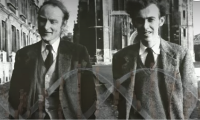Is it Protein or DNA that carries genetic information?
The landmark discovery
Now we pretend it is the year 1951 and we should know the following (admittedly a biased list):
- 1. Traits are propagated from one generation to the next by genes.
- 2. The genes are in chromosomes.
- 3. Chromosomes consist of proteins and nucleic acids.
- 4. Nucleic acids are bigger molecules than proteins.
- 5. Amino acid chains can form complex three-dimensional structures.
- 6. The transforming agent of non-virulent to virulent bacteria is deoxyribonucleic acid (nucleic acid).
- 7. Nucleic acids consist of four different nucleotides.
- 8. Twenty different amino acids make up proteins.
- 9. Chromosomes and viruses are capable of self-replication. Thanks to the invention of the microscope, first seen in Europe around 1620
- 10. Finally, we pretend not to know about William Astbury's X-ray diffraction photographs showing a potential systematic structure of DNA.
The following prerequisites must be a fulfilled by a successful candidate molecule:
- 1. Able to form enough variations to allow the storage of an enormous number of inheritable traits.
- 2. Must be stable and durable.
- 3. Allow some mechanism to copy it. Alternatively, self-replicate.
So, is it protein or nucleic acid (DNA) that mediate the genetic information? Let's add one additional puzzle piece. In 1952, Alfred Hershey and Martha Chase published the results of their experiments(*) on the transformation of bacteria (E. coli) using bacteriophages. Bacteriophages infect bacteria, and their two building blocks are protein and DNA. Hershey and Chase discovered that only DNA penetrates the bacterial cell wall. In the paper, they concluded that "... protein probably has no function in the growth of intracellular phage. The DNA has some function." They didn't directly say that DNA is the carrier of genetic information. Preceding evidence of DNA carrying the genetic information was published by Oswald Avery, Colin MacLeod, and Maclyn McCarty eight years earlier, in 1944. Hershey won the Nobel Prize in Physiology or Medicine, shared with Salvador Luria and Max Delbrück, in 1969, "for their discoveries concerning the genetic structure of viruses.”
Amount of evidence for DNA is the carrier of genetic information was piling up. All the earlier evidence together with the recent Hershey's and Chase's results led to increased interest in DNA's chemistry and its geometry.
In December 1952, Linus Pauling and Robert Corey submitted their paper, "A PROPOSED STRUCTURE OF THE NUCLEIC ACIDS." published on February 1953. Their model, unfortunately, or fortunately, depending on the point of view, wrongly consisted of three chains.
About two months later, on April 25th, 1953, Nature published Watson's and Crick's landmark paper, "Molecular Structure of Nucleic Acids: A Structure for Deoxyribose Nucleic Acid." In this paper, they proposed a DNA structure, which was later confirmed to be correct. Three key information pieces were crucial in leading to the discovery:
1. Chargaff's rules
Amount of adenine and thymine are equal, and amount of guanine and cytosine are equal. This fact may lead to the (correct) assumption that adenine (A) should pair with thymine (T) and cytosine (C) with thymine (T). The next question is, how do they bond?
2. Rosalind Franklin's X-ray diffraction image
Maurice Wilkins showed the image to Watson and Crick. Based on this image, Watson and Crick recognized that the DNA structure was helical. The density of the X-ray image suggested the structure should consist of two chains, not of one according to the chemical formula. Despite this, the previous question remained unanswered, how do they bond?3. Correct guanine and thymine carbon ring configuration
At the time the organization of atoms in guanine and thymine carbon rings was wrong in most textbooks. A visiting scientist at the Watson's and Crick's office, Jerry Donohue explained the correct configuration.
Now, armed these three pieces of knowledge, the task was to find out the bond configuration of A with T and C with G. Watson famously made cardboard models of the bases and tried various arrangements, until he discovered the correct hydrogen bonds on guanine binding with cytosine and adenine binding with thymine. Consequently, the structure emerged as the double helix.

Watson and Crick were probably worried that someone else would manage to decipher and publish a structure of DNA before them. This is the likely reason why their famous Nature article was only a single page. In conclusion, they wrote the now famous sentence, "It has not escaped our notice that the specific pairing we have postulated immediately suggests a possible copying mechanism for the genetic material." Soon after, May 30th, 1953, Watson and Crick published their postulate of the copying mechanism of DNA, where each of the two DNA strands is used as a template to produce a new opposite strand (semiconservative hypothesis). The two resulting helices would then consist of one newly synthesized strand and one original
Max Delbrück proposed a competing model where some mechanism breaks both DNA strand at every ten nucleotides so that both resulting double strands would consist of alternating original and newly synthesized strands (conservative hypothesis) (*).

David P. Bloch offered, one and a half years later, an alternative explanation for the copying mechanism, where one of the resulting double helices consisted of newly synthesized strands and the original strands were intact (dispersive hypothesis) (*).
Watson's and Crick's hypothesis was the correct one. Meselson and Stahl experimented using E. coli bacteria containing two different nitrogen isotopes; thus, they could follow the faith of each DNA strand. They published the results in 1958 in PNAS, supporting the semiconservative mechanism (*).
In 1962, Watson, Cricks, and Wilkins were jointly awarded the Nobel Prize in The Nobel Prize in Physiology or Medicine "for their discoveries concerning the molecular structure of nucleic acids and its significance for information transfer in living material." The Nobel Foundation's statutes paragraph four states that "Work produced by a person since deceased shall not be considered for an award." Rosalind Franklin died earlier 16 April 1958 and was not awarded the prize.
